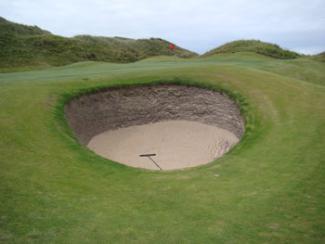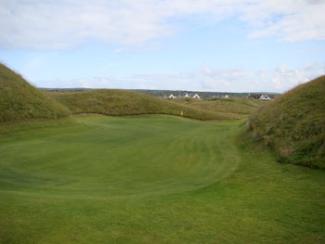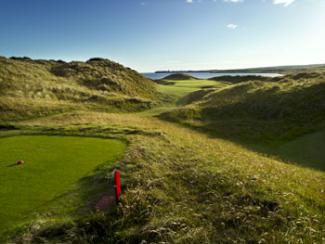Featured Golf News
Ireland's Stunning Lahinch Meshes Old & New
Given that golf has been played at Lahinch Golf Club since Good Friday 1893, the tradition here is as thick as the fog that rolls in at the drop of a hat or the time it takes to drive of a ball over and through its huge grass-covered dunes.

The 13th Hole at Lahinch Golf Club
But the links on Ireland's southwest coast - ranked among the top-50 golf venues in the world - is a combination of old and new, thanks to a careful stewardship of the things that have been great about the course through the years and a series of changes that improved playability.
Lahinch was founded when Scottish officers of the Black Watch Regiment stationed in Limerick came upon a vast expanse of dunelands on the edge of the Atlantic Ocean and routed a track that skirted the site's sand hills. In 1894, the course was redesigned by Old Tom Morris, who considered the links as one of the finest natural courses he had seen and pushed it more into the dunes.
George Gibson added a few beachside holes in 1907, but the most significant phase came in 1927 when Dr. Alister MacKenzie shifted the entire course into the bigger coastal dunes, added a number of new greens and stretched and modernized the layout.
MacKenzie, a minimalist before the term was even coined, believed in using the existing attributes of a site and keeping a course's natural appearance. At Lahinch, holes weave through the dunes and the greens roll with the endemic lay of the land.

Behind the Sixth Hole at Lahinch's Old Course
The course at Lahinch that eventually rose to international prominence is a combination of the work of all these designers that was enhanced by a five-year restoration from 1998-2003 marshaled by British architect Martin Hawtree, who recently has been lauded for his design of the new Trump International Golf Links in Scotland.
Hawtree's work left only four greens (at the fourth, ninth, 14th and 18th) untouched and 16 tees were rebuilt, two new par-3s were created and four holes extensively rerouted.
Among the improvements was the amplification of trouble around the greens.
Lahinch's bunkers, swales and mounding now make approaches from any distance a distinct challenge. The "restored MacKenzie" course has received a rapturous reception.
The Old Course is one of two 18-hole tracks at Lahinch Golf Club, one of Ireland's oldest clubs. The par-72 layout stretches 6,950 yards from the tips and winds through towering dunes that guarantee several blind shots. The unpredictable winds off the nearby ocean add an interesting twist.

A Mine Bunker Right of Lahinch's 11th Green
Occupying a corner of duneland with the Atlantic Ocean on one side and a river estuary on another, the views are never dull from this spectacular course. You rarely see another hole as most are enclosed within the towering dunes, and the welcome that visitors receive - both at the course and in its namesake town - is warm and wonderful.
Lahinch's routing features strategic driving lines and intricate - and unconventional - greens complexes, all a result of MacKenzie's ability to tie together his own ideas with the work by Gibson and Morris.
Since 1895, Lahinch has hosted the South of Ireland Championship, the oldest provincial golf tournament in Ireland and a highlight of the club's year. Lahinch has also hosted all of the Emerald Isle's major events, amateur and professional, over the years.

The Fifth Green is Between Two Huge Dunes
Synergy Rules at Lahinch
The experience at Lahinch is much more than the sum of its parts thanks to the setting, the swirling winds that baffle even the best players, and an untamed atmosphere unique among the world's top courses.
Overlooking the stunning County Clare coastline, the course first plays along the sea toward the estuary that bisects the site before heading back along the main road into town. Lahinch's primitive ambience is enhanced by a herd of goats that live on the course, and ruins on the adjacent Castle Course.
After a solid opener, the first hint of genius comes at the 446-yard par-4 third, an awesome driving hole over a large dune that then turns seaward and follows a succession of humps and hollows into a cleverly positioned plateau green.

Lahinch GC's 11th Hole
Lahinch's most famous holes (and two of the most renown in the Emerald Isle) are the 475-yard, par-5 fourth and the 154-yard, par-3 fifth, each of which sports green fronts veiled by huge dunes. Both designed by Old Tom, the holes have remained virtually untouched since for almost 120 years; the thought of building such holes today would probably be considered ridiculous.
No. 4 is an odd par-5 that plays closer to a par-4 in the modern era, but the second shot is straight over a towering dune. You can't see the green or anything else from the fairway, so players just have to let it rip over the white aiming stone and hope the ball finds home.

Lahinch Golf Club's Old Course
The fifth is even more bizarre, playing uphill over a huge dune to a green nestled on the other side and in front of another steep-sided, grass-covered mound. The putting surface is completely obscured from the tee. A small white rock atop a tall dune adjusted daily for the pin's location is the only aiming clue. The green, sandwiched between the two massive dunes, is extremely shallow - just 18 paces at it widest point and 12 paces at its narrowest.
Lahinch's prettiest hole is likely the 424-yard, par-4 sixth. Playing uphill off the tee, there's little visibility. But once the player follows the fairway that moves right to left around a corner, the downhill approach to the green by the sea is a sight to behold. A giant, 15-foot-deep "mine" bunker that beckons long hitters at about 270 yards from the back tees is more of a black hole, funneling most nearby shots into its depths.
The Old Course at Lahinch has a wonderful set of par-3s, including the 166-yard eighth. The hole is in the dunes at one of the highest points on the property, so winds are a huge factor here. The tee shot is played uphill and must carry a huge valley covered in native grasses. The right side of the green is actually built into a dune, and two pot bunkers are to the right, with another mine bunker left.
The 400-yard, par-4 ninth is another gem, rising up a slanting fairway and then heading back down into a slender shelf of a green cut into a hillside.

Lahinch's Eighth Hole
Back Nine Bears the Test of Time
While the majority of the front nine occupies the club's most rugged land, the inward half offers a wonderful combination of solid, risk-reward tests. The 170-yard, par-3 11th plays slightly downhill. There's some room short and left, with a shallow bunker just left of the green and another before the putting surface. The right side of the green falls off dramatically, and a pot bunker - the course's deepest - gobbles up errant shots. The vertical face of the bunker is a sod wall, and the ground above and short of the bunker will feed balls into it.
Playing along the edge of an inlet and a bridge, the 577-yard, par-5 12th - with Castle Dough in the distance serving as the line off the tee - involves one of the Lahinch's best tee shots and one of its narrowest putting surfaces.
The reachable, 279-yard par-4 13th may be one of the most ingenious holes in MacKenzie's massive portfolio, and it's certainly one of the top holes at Lahinch. Nestled among dangerous sand hills, the green is a tempting target, but a successful drive must negotiate a narrow central fracture and flirt with a deep bunker in order to reach the angled putting surface.
The 195-yard, par-3 16th heads downhill to a target heavily protected by bunkers. A stone wall separates the green from the road in back.

Looking toward Castle Dough at Lahinch GC
The course finishes with a 534-yard par-5 that has been lengthened. It crosses through the fourth fairway and near the fifth tee. It's about as flat a hole as you'll find at Lahinch, but there are enough undulations to make the fairway - guarded on both sides by bunkers - difficult to master.
The Old Course at Lahinch is a thinking man's track, where imagination is not only rewarded but required. Golfers won't play the same shot twice and success will come via accuracy and course management rather than sheer power. The rough is normally about knee-high, making precision paramount.
Molded and shaped over centuries by nature's harsh elements and an occasional touch of human genius, Lahinch GG's Old Course boasts perfect natural golfing terrain - a true links and an unforgettable experience.
For more on Lahinch, visit www.lahinchgolf.com. To inquire about tourism in Ireland, check out www.failteireland.ie.
Steve Habel is one of Cybergolf's world correspondents, contributing news stories, features, equipment and book reviews and personality profiles from his base in Central Texas. He is also works as a contributing editor for Horns Illustrated magazine, a publication focusing on University of Texas sports, covers the Longhorns for CBS Sports, is regional editor for Texas Golfer magazine and files stories for Golf Oklahoma magazine, Texas Links magazines and Golfers Guide. Habel's main blog (www.shotoverthegreen.blogspot.com) features news on golf and the Longhorns, and another (www.checkinginandplayingthrough.blogspot.com)chronicles his many travels, on which he has played more than 350 golf courses since 2009. Habel is a member of the Golf Writers Association of America and the Texas Golf Writers Association.
Story Options
 |
Print this Story |
